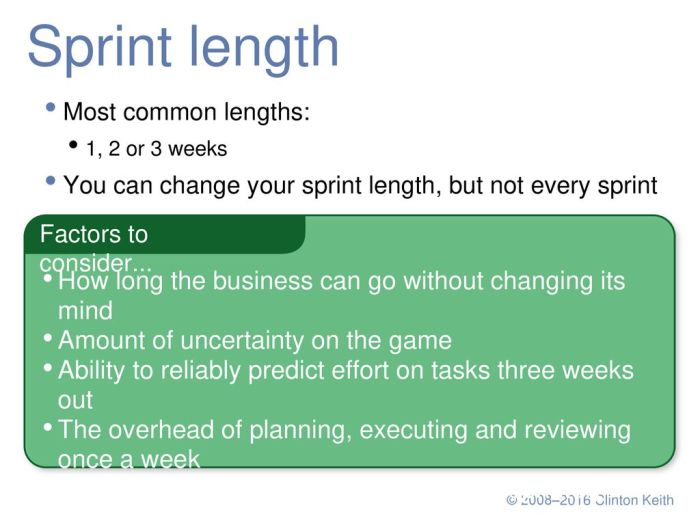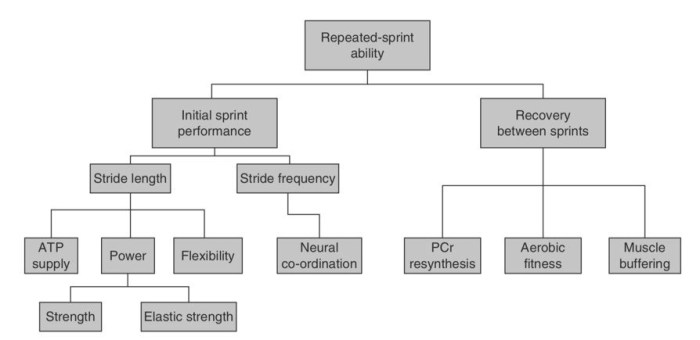What factors should be considered when establishing the sprint length? This question is crucial for optimizing team performance and project outcomes. Understanding the various factors that influence sprint duration is essential for agile teams to make informed decisions and achieve successful results.
Team size, project complexity, and organizational culture are among the key factors to consider when determining sprint length. Additionally, resource availability, customer feedback, and historical data play significant roles in shaping sprint duration.
Factors Influencing Sprint Length: What Factors Should Be Considered When Establishing The Sprint Length

Determining the optimal sprint length is crucial for effective agile development. Several factors influence this decision, including team size and composition, project complexity, organizational culture and practices, resource availability, customer feedback and involvement, historical data and performance metrics, external factors, iterative and incremental development, learning and improvement, and risk management.
Team Size and Composition
The size and composition of the development team can significantly impact sprint length. Larger teams may require longer sprints to facilitate coordination and communication. Similarly, teams with diverse skill sets or experience levels may need additional time to ramp up and collaborate effectively.
Project Complexity
The complexity of the project plays a vital role in determining sprint length. Complex projects with numerous dependencies or technical challenges may necessitate longer sprints to allow for thorough planning and execution. Conversely, simpler projects with well-defined requirements may be suitable for shorter sprints.
Organizational Culture and Practices
The organizational culture and established practices can shape sprint length. Agile methodologies, such as Scrum and Kanban, often recommend shorter sprints to promote flexibility and rapid feedback. In contrast, organizations with more traditional project management approaches may prefer longer sprints to align with established timelines and reporting cycles.
Availability of Resources
The availability of resources, including personnel and equipment, can affect sprint length. Resource constraints may necessitate shorter sprints to ensure timely completion of tasks. Conversely, ample resources may allow for longer sprints to accommodate thorough testing and quality assurance.
Customer Feedback and Involvement, What factors should be considered when establishing the sprint length
Customer feedback and involvement can influence sprint length. Frequent customer feedback loops may require shorter sprints to incorporate changes and iterate quickly. Conversely, projects with limited customer involvement may benefit from longer sprints to allow for more comprehensive planning and development.
Historical Data and Performance Metrics
Historical data and performance metrics can provide valuable insights for determining sprint length. Past sprint durations and outcomes can inform future planning by identifying patterns and areas for improvement. Teams can leverage this data to optimize sprint length for their specific context.
External Factors
External factors, such as market conditions or regulatory changes, can impact sprint length. Unexpected events or disruptions may necessitate sprint adjustments to accommodate changes in priorities or resources.
Iterative and Incremental Development
Iterative and incremental development approaches can influence sprint length. Breaking down projects into smaller increments may allow for shorter sprints, as each increment can be completed and tested independently.
Learning and Improvement
Sprint length can impact team learning and improvement. Shorter sprints facilitate faster feedback and iteration, enabling teams to learn and adapt quickly. Conversely, longer sprints may provide more time for experimentation and exploration.
Risk Management
Sprint length can affect risk management. Shorter sprints may reduce the risk of project delays or failures by allowing for more frequent course corrections and mitigating potential issues early on.
FAQ Corner
What is the ideal sprint length?
The ideal sprint length varies depending on factors such as team size, project complexity, and organizational culture. However, most agile teams find that sprints ranging from one to four weeks are effective.
How does team size impact sprint length?
Larger teams may require longer sprints to accommodate coordination and communication needs, while smaller teams may be able to work effectively with shorter sprints.
How does project complexity affect sprint length?
Complex projects may require longer sprints to allow for thorough planning and execution, while simpler projects may be suitable for shorter sprints.


